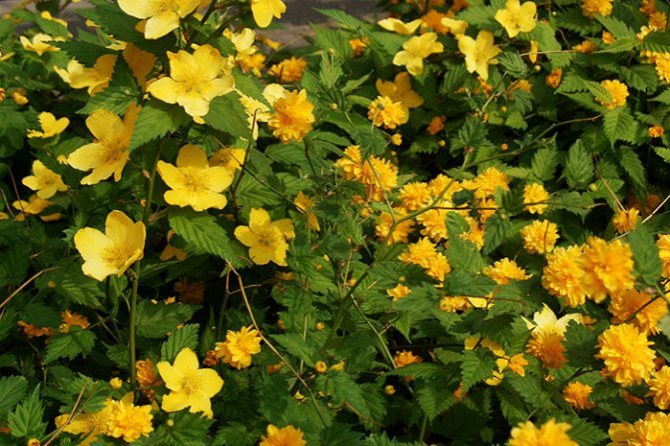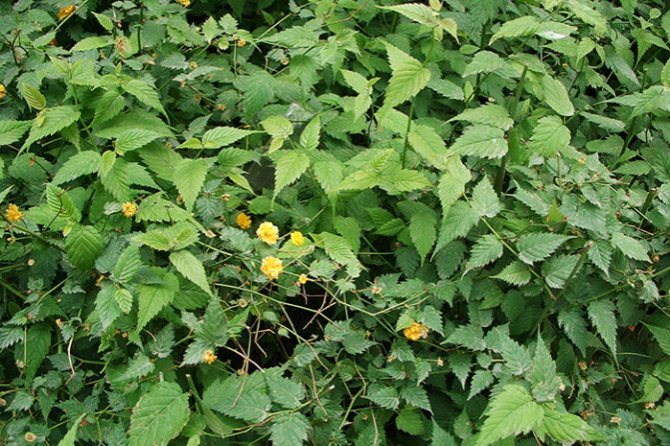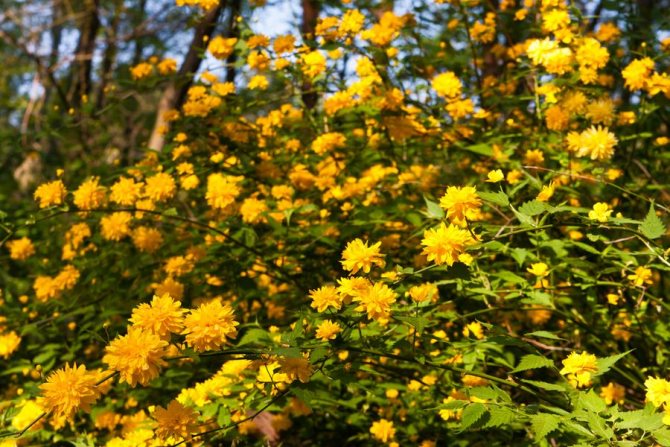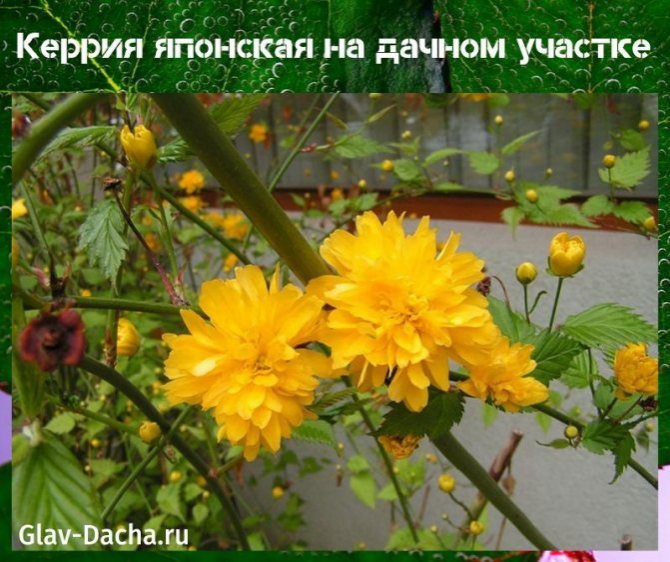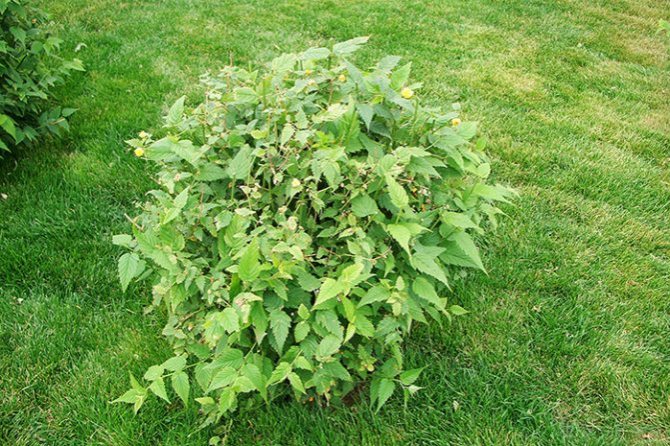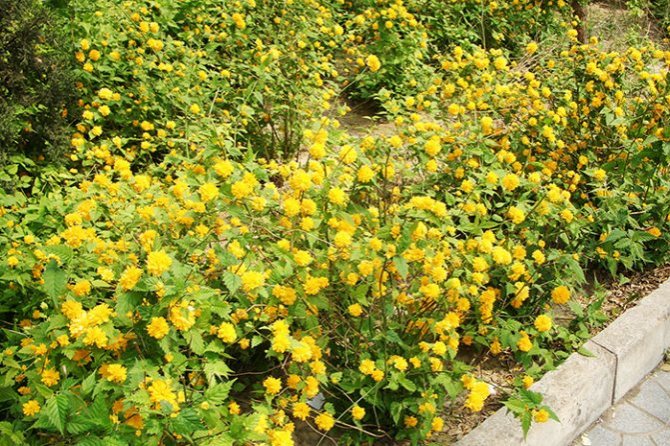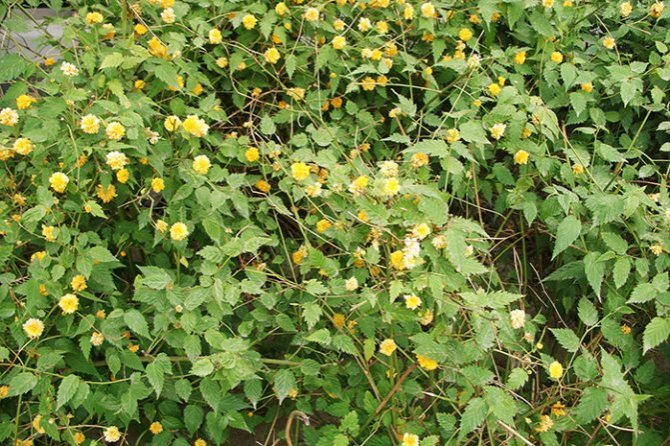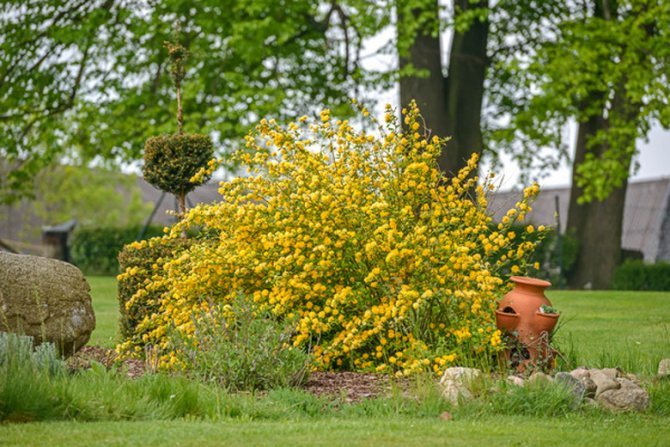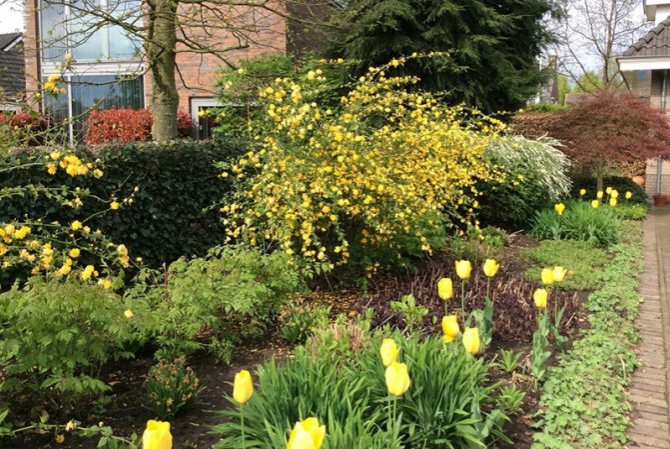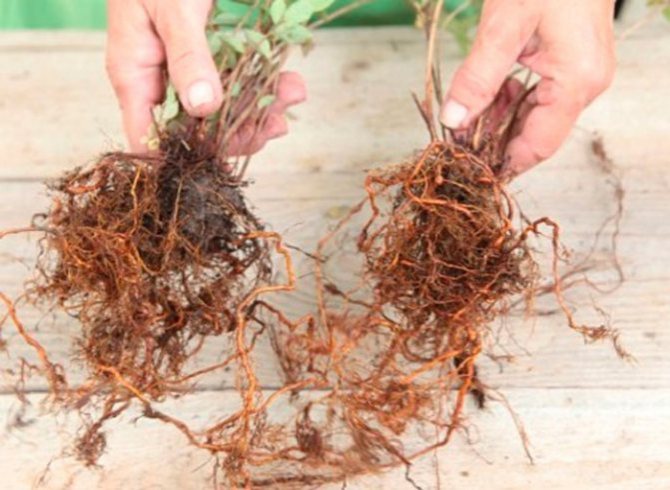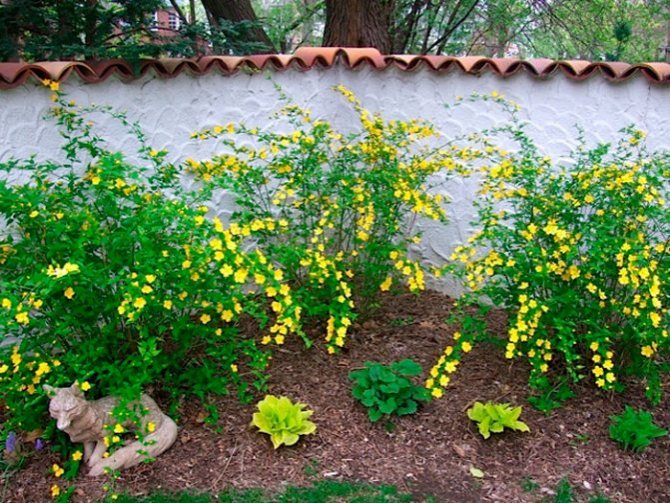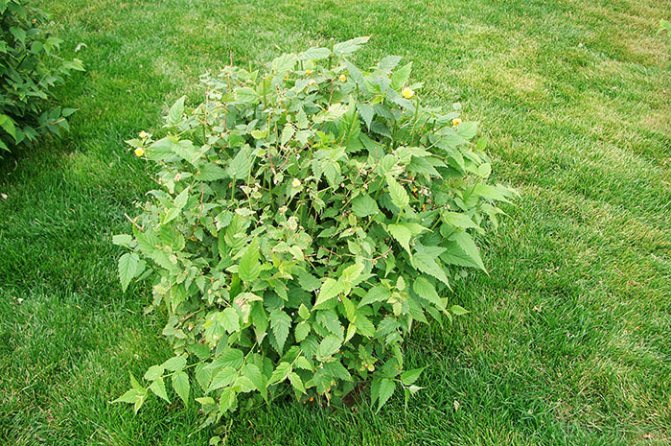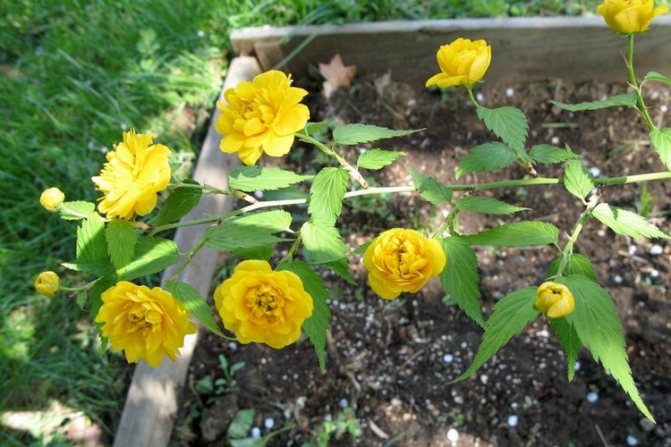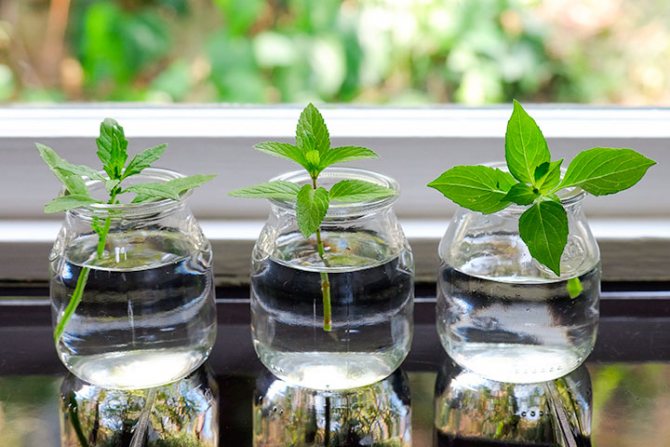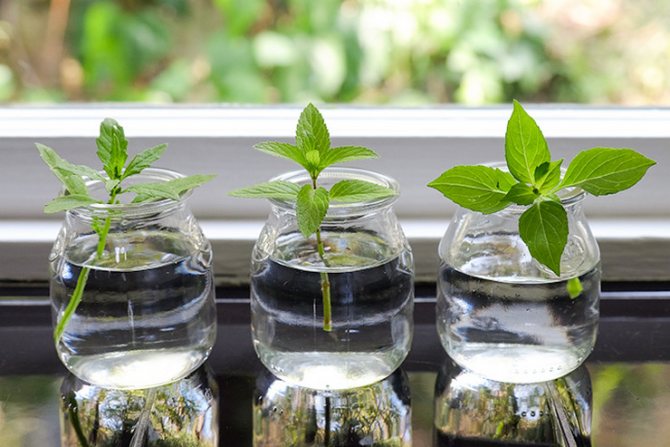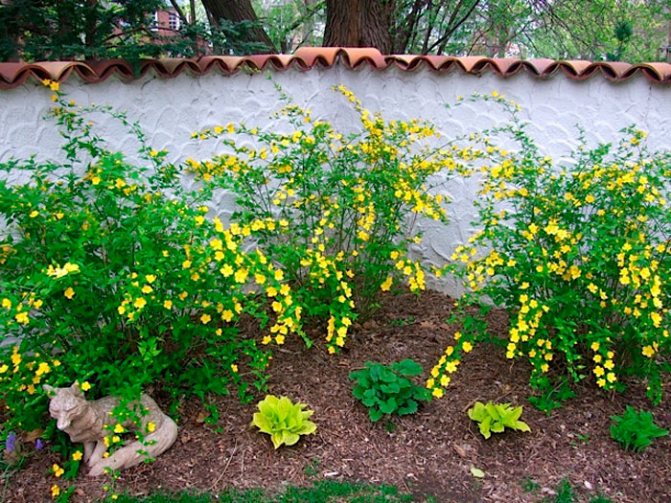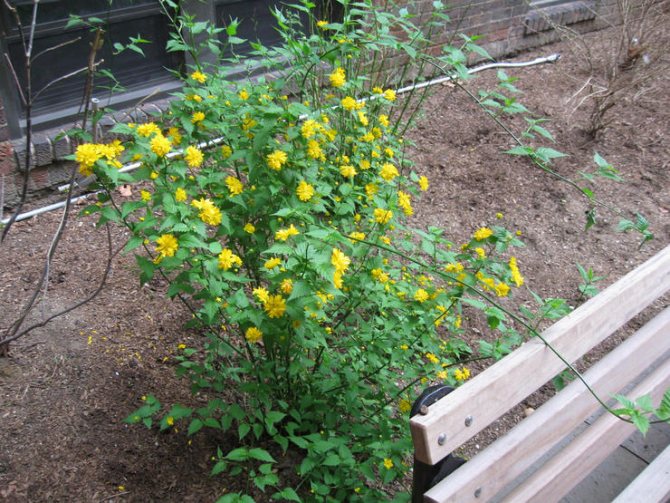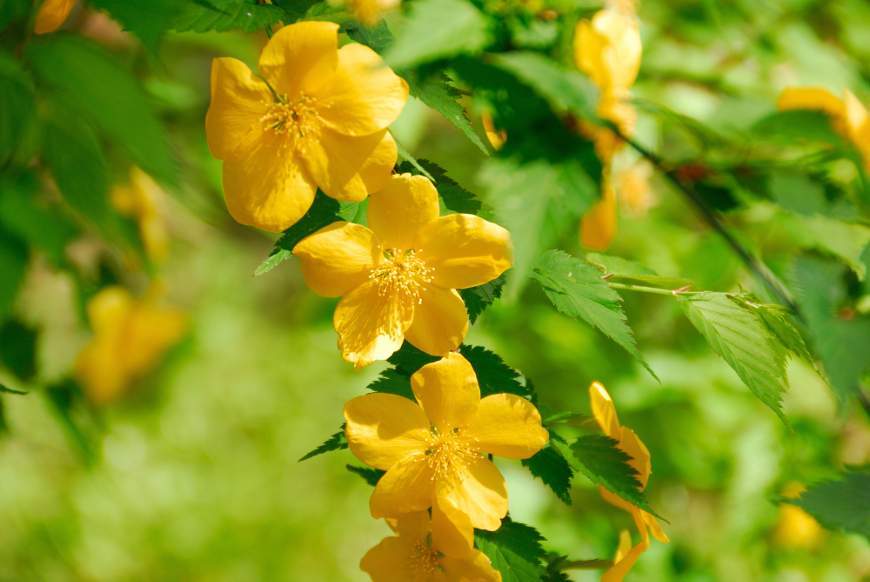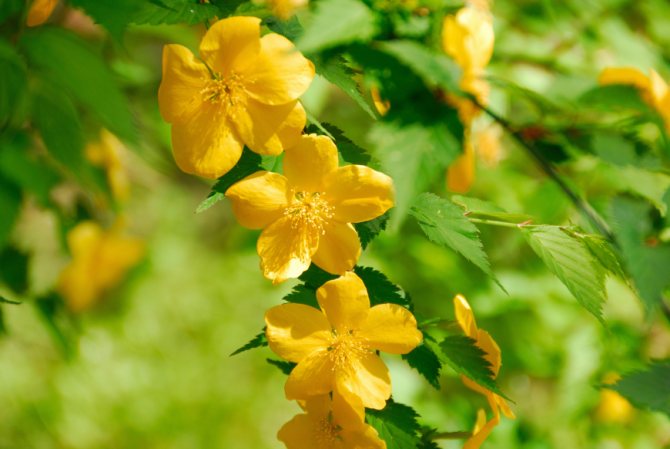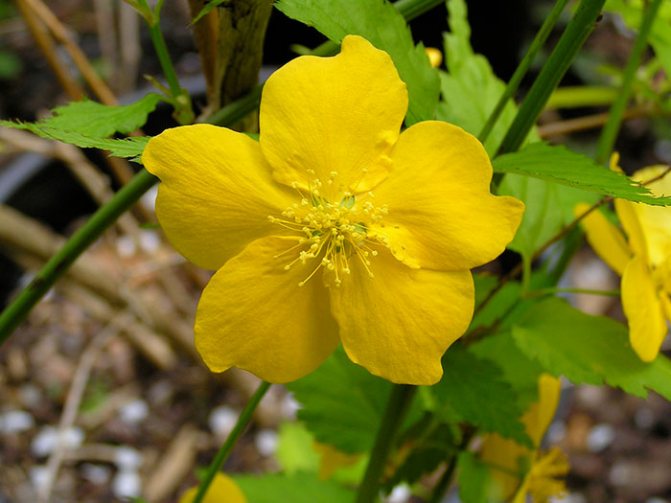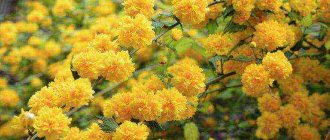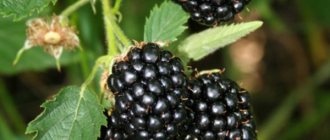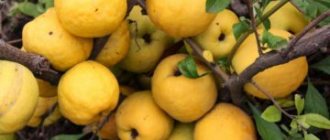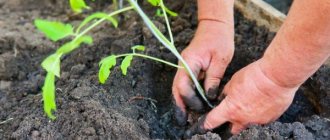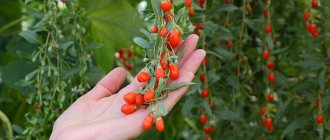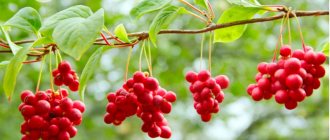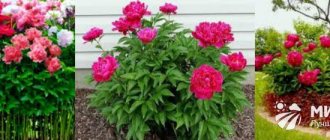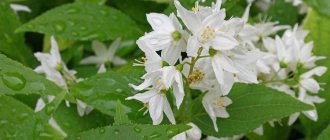Kerria Japanese (Kerria japonica) is a beautiful deciduous shrub of the Rosaceae family, genus kerria (Kerria), the only species is kerria japanese (K. japonica). It is an ornamental shrub with light green leaves. They have jagged edges and well-visible depressed veins. The twig-like green branches of the kerria turn brown in the lower part, but this does not spoil the general appearance of the bush. From a distance, it appears green even when it sheds all its foliage.
Kerria japonica during flowering
Japan and China are considered the birthplace of the Japanese kerria. There, the bushes form thickened thickets. Kerria Japanese feels good in those European countries where the climate is warmer and milder than ours. In the conditions of the Moscow region, it is difficult for this shrub to adapt to the winter weather. He often has to survive due to the ability to quickly recover and grow new shoots. But even partial freezing affects the quality of flowering.
Bloom... Kerria flowers are simple (basic type) and double-shaped. The basic form has five bright yellow petals with a diameter of 4 cm or more. The double form (f. Plena) has flowers that look like tiny golden roses with many petals.

Simple kerria flowers are usually larger than double ones.
In the suburbs of Moscow, Japanese kerria blooms from the end of May. The timing of the beginning of flowering can be shifted due to weather conditions. In kerria, like forsythia, the first simple or double flowers begin to bloom on bare stems, light green leaves soon appear. Flowering lasts from three weeks to a month. During this period, the shrub looks amazing. Only a few flowers appear during the summer. Weak re-flowering often occurs in autumn.
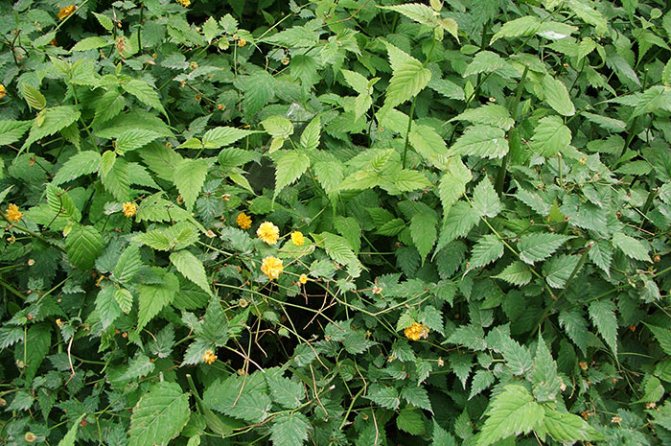

Individual flowers bloom all summer
Unfortunately, the Japanese kerria bush can disappoint people who compare it to pictures in magazines or to those plants covered with flowers that have been seen in other countries. Only with good preparation for winter can you achieve a stable result and grow a shrub with lovely flowers. I switched to growing Japanese kerriya as a houseplant, which is exhibited on the site in the summer.
Planting and caring for kerrias
- Bloom: about a month until July, but can bloom again in autumn.
- Landing: in spring (before the start of sap flow) or in autumn, at the beginning of October.
- Lighting: bright sun or partial shade.
- The soil: moist, fertile, rich in humus, loamy.
- Watering: as needed: the topsoil should dry out between waterings. In heat and drought, watering is frequent and abundant.
- Top dressing: after flowering - mullein infusion (1:10) or rotted compost mixed with wood ash.
- Cropping: in the spring, before the buds swell, sanitary pruning is carried out. After flowering, shoots that have reached four to five years of age are cut, and young shoots are slightly shortened.
- Reproduction: dividing the bush, layering, cuttings and shoots.
- Pests and diseases: the plant is very resistant.
Read more about growing kerrias below.
Solar splendor kerry
Among the ornamental shrubs, Japanese Kerria is considered a special, rare and exclusive star. It is not as popular as forsythia.Often the plant is overlooked, thinking that such its splendor and showiness is a sign that the plant will have to provide difficult and tireless care. But kerria is one of the most unpretentious plants that can be recommended even to the most inexperienced gardeners. The endurance and simplicity of this shrub can only compete with its decorative merits.
Kerria Japanese (Kerria japonica) - Oriental in origin, and in style too, an ornamental deciduous shrub from the Pink family. The specific name of kerria often leads to confusion, because the birthplace of this plant is actually not Japan, but China. The folk names of the plant are a vivid evidence of its extraordinary beauty of flowering. Easter or Japanese rose - this is how kerria is known all over the world, and it is especially loved in European landscape design.
The average height of kerrias is limited to 1.5-2 m (up to a maximum of 3 m kerrias grow both in nature and in free growing without forming in gardens), easily regulated by shaping and pruning. They are compact, deciduous shrubs with slender shoots. The shoots of kerria are green and straight, they initially form a rather strict pyramidal crown, but with age the shrub becomes more and more lush and curly, the shoots bend, the shape of the bush changes. One of the most valuable features of the Japanese kerriya is its strikingly elegant, not too thick, but seemingly curly crown. This shrub seems fluffy and elegant at any time of the year, even in winter, impressing with its lace pattern and bright light green color of the shoots. Kerria shoots are thin, look amazingly graceful and only emphasize the beauty of the plant. All kerrias have medium-sized, but beautiful lanceolate leaves, the length of which ranges from 2 to 10 cm, and the width is up to 5 cm. The serrated edge of the leaves adorns the plant, as does their rich light green color in summer. The underside of the leaves is pubescent, the upper side is bare. The yellow spring and autumn flowering of kerria seems to be picked up by the crown: in the fall, the leaves of the plant are repainted in a bright yellow color, completing the yellow parade of the plant.
Features of Japanese kerria, reproduction and care
Bright sun balls of blooming kerria are eye-catching, and the delicate scent is pleasant. Seeing this shrub during flowering, many gardeners light up the idea of planting it at home. This article was written to help inexperienced lovers of beautiful and exotic perennials learn how to care for keria. In order to have such a beautiful shrub on your personal plot, it does not take much effort.
Description
In nature, perennial grows in the mountainous regions of Japan and China. With its great beauty of stems and flowers, it is used in garden design. The culture has another name: Easter rose.
The plant belongs to the deciduous shrubs of the Rosaceae family, which grow rather quickly and reach a height of 3 m. The bushes have twig-like shoots that form a crown in the form of a cone.
The leaves of the Easter rose are lanceolate, pointed, slightly toothed. On the underside, the leaves are slightly fleecy, and on the upper side they are bare. In spring and summer, the color of the leaves is green, and in autumn it is yellow.
The flowers have a diameter of about five centimeters, resemble yellow roses and have a pleasant aroma.
The shrub blooms for about a month, sometimes even twice: in early spring and in mid-autumn. After flowering, sparse flowers often appear on the bushes throughout the summer season.
The fruits are juicy, black-brown drupes that are not used for food. But in the harsh climate of the middle zone, they are not tied.
The stems of the plant also look pretty decorative, but they are very brittle. Strong winds can easily break them, so shrubs need protection from the wind.
Forms and varieties
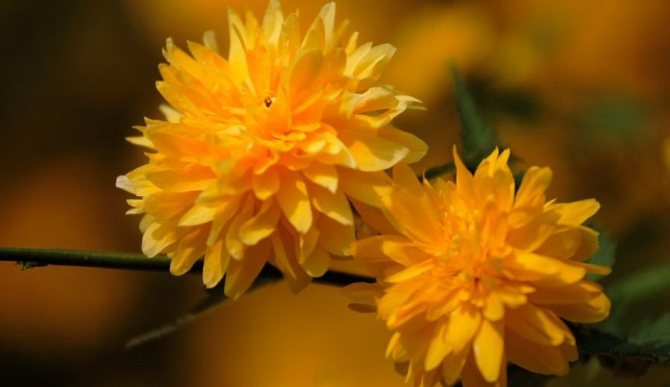

Kerria growing in nature has simple flowers.Bred cultivated species often have spectacular double flowers, similar to roses or golden balls. The most common garden varieties are:
- Pleniflora is a shrub that in spring is covered with medium-sized double flowers, reminiscent of pompons.
- Golden Guinea is distinguished by the grace of leaves and the simplicity of large flowers (about 6 cm).
- Variegata (or Picta) differs from other varieties in simple flowers of 5 petals and a decorative shape of the leaves of a grayish-green shade with a cream border.
- Albomarginate is distinguished by a white border on the leaves.
Where to plant
Kerria needs fertile, moist soil, more often it grows on fertile loams
The perennial prefers well-lit places, sheltered from the cold wind. The Easter rose, as a rule, is planted in places closed from strong drafts. And in areas where strong winds constantly blow, it is not planted.
Kerria grows well in half-shady places, but it does not bloom so luxuriously. However, if the plant is in bright sun, its flowers become pale, and the tips of the petals become whitish. With a lack of light, the shoots stretch out, the leaves on them become rare, such a bush blooms rarely, if at all.
When to plant
The plant should be planted in early spring, before the buds appear. You can, of course, do this in autumn too, no later than a month before frost.
How to plant
It is very important before planting to dig a deep hole up to 1.5 m deep and 0.6 m wide.Crushed brick or gravel up to 0.7 m thick is placed on its bottom.Then, humus is laid with a layer of about 0.3 m.You must first add compost, mixed with soil, ash (glass) and mineral fertilizer (about 70 g). Then pits with a diameter of 0.6 m are prepared, where additional compost mixed with soil, ash (glass) and mineral fertilizer (about 70 g) are added.
When planting, the neck of the roots is not buried. If the neck goes into the ground, you need to lift it up and add earth. After the plant is planted, it is watered and then mulched.
Proper cultivation of kerrias includes regular watering and feeding, sheltering for the winter, pruning the plant in the spring, and keeping it out of strong sunlight.
Watering
For a kerry plant, yellow planting and care does not require special action, but requires regular watering, especially in dry hot weather, but it does not tolerate excess moisture either. Watering the shrubs should be plentiful, but there should be no stagnation of moisture. The soil should not dry out deeper than 10 cm deep.
Top dressing
The perennial responds to fertilization. In July, at the end of flowering, mullein infusion is added to the soil. In some cases, the procedure can be repeated after a couple of weeks. Instead of mullein, you can add matured compost with added ash (no more than 200 g per m2). Mineral fertilizers are added to the water for irrigation so that they are absorbed by the soil and then absorbed by the roots of the plant.
Pruning
This care element is a prerequisite for maintaining the decorative form. Frozen and broken branches are cut early in spring. Healthy shoots are shortened, preferably 1/3, to stimulate branching development. At the end of flowering, the faded branches are cut to branches that have not bloomed, because neither of them will form buds for autumn flowering. At the same time, the plant is rejuvenated by pruning, removing all shoots older than four years. In the case of strong thickening of the shrub, it is thinned out. Pruning the plant is very beneficial as it grows very quickly.
How to prepare for winter
The shrub is quite unpretentious, but nevertheless, in the second half of autumn, kerrias are sheltered from the cold. Do in dry weather, bending the shoots to the ground. They are laid on dry polystyrene, for example, branches are pinned, covered with dry foliage.A fixing frame is built on top, not only holding the branches, but also not allowing them to be broken by wind or snow. The shelter should be ventilated so that the bushes do not squeeze, therefore agricultural canvas is not always appropriate here.
How to open in spring
With the arrival of spring, the shelter must be removed gradually. And it is better to do this if the sun is covered with clouds. It is unacceptable to open the plant right away: tender young shoots will get burned, and the plant may die. If the kerria suffers, of course, it will grow back quickly, but you should not expect a lush flowering. If it blooms at all.
Reproduction of Japanese kerria
Reproduction is mainly carried out by cuttings. Cuttings are harvested during spring pruning. Rooting of cuttings of this culture occurs without complications. This method of reproduction is within the power of even the most inexperienced gardener.
For green cuttings, you need to select apical branches up to 6 cm in length. They are cut with a sharp knife or garden scissors, placed in water, adding succinic acid tablets. Dilute acid in the amount of 4 tablets per liter of water. This promotes root formation. After the small roots have appeared on the cuttings standing in the water, they are deepened into the ground of the greenhouse, covering them from above. By autumn, wonderful seedlings develop from these cuttings, but they can be planted in the place of constant growth only in spring.
You can also propagate this plant using layering. Seedlings, of course, will turn out to be much smaller than the material, but it is safer to propagate it this way. This is done in early spring, when the buds are still swollen.
- Near the bush, you need to make grooves 7 cm deep.
- Healthy shoots are placed in each groove and pinned, trying to keep them intact.
- After 10-14 days, green shoots begin to sprout from the shoot buds.
- After germination by 10 cm, the grooves are sprinkled with soil about 6 centimeters.
In the fall, the obtained seedlings can be transplanted to a new place.
Diseases and pests
Kerria is extremely rarely affected by pests. With sufficient and proper care, the plant is not susceptible to disease. Therefore, there is no need to talk about the diseases of this plants.
Using
Kerria is very good at creating deciduous green fences. High endurance in relation to sunlight allows unusual design of those parts of the garden where other shrubs cannot take root.
She gets along with primroses such as:
- periwinkle;
- grouse;
- lungwort;
- primrose or forget-me-nots.
In the composition of green hedges, kerria is used in the back rows.
Japanese azalea: features of care and reproduction
Plant gentian yellow: description, cultivation and medicinal use
Cornflower large-headed yellow - botanical description and application
Japanese guest - anemone
Derain white - Elegantissima: features of care and reproduction
Tamarix shrub - beaded beauty in the garden, grown without difficulty and always delighting everyone
Kerria shrub - description
Kerria japonica is a deciduous, fast-growing shrub up to 3 m high with straight green twig-like shoots that form a crown in the form of a cone. Kerria leaves resemble raspberry leaves: up to 10 cm long, lanceolate, double toothed, pointed to the tops, glabrous above and pubescent on the lower side. They are light green in summer and bright yellow in autumn. Single, fragrant, simple or double kerria flowers up to 4.5 cm in diameter bloom for 25 days from May to August, in autumn the plant often blooms again. The fruit of kerria is a juicy black-brown drupe, but in the conditions of the middle lane the plant does not form fruit.
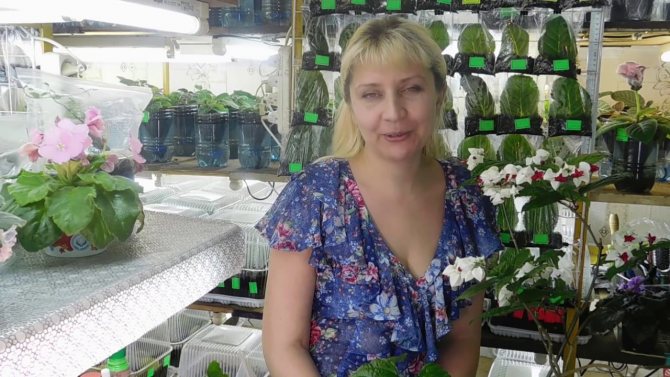

Thin shoots of kerrias can break from strong winds, so it is advisable to plant them surrounded by such flowering shrubs as spiraea, bubblegum or Chinese tea.In the midst of spring, it can serve as a spectacular backdrop for blue aquilegia, blue phlox spread out, dwarf purple irises, and nearby you can grow a buzulnik, which will be in harmony with kerria during its autumn flowering.
Popular varieties of Japanese kerriya
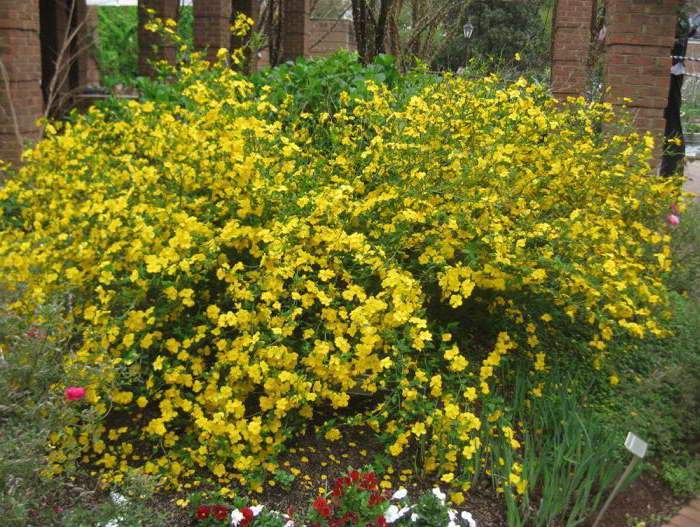

Kerria japonica Golden Guinea Kerria japonica Golden Guinea photo
The most famous variety of Japanese kerriya is the Pleniflora variety with large double flowers. There are several variegated forms. The most popular are Variegata and Picta. The bushes are slightly lower in height, have simple flowers, the leaves are light green in color, covered with white spots.
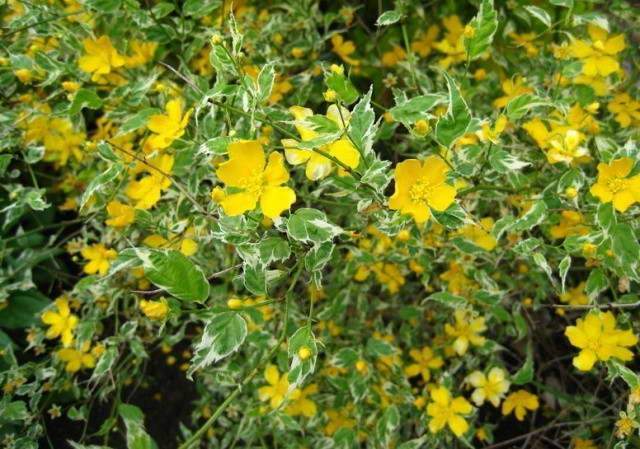

Kerria japonica Picta Kerria japonica Picta photo
The exquisite flexibility of the shoots, the beauty of the leaves, combined with the pretty bloom, make the kerria charming. The inhabitant of the south is well adapted to the conditions of the middle zone and the Moscow region. The bush can freeze to the level of snow, but quickly recovers and gives a lush bloom. You will be surprised, but in our gardens it is quite rare.
Types and varieties


It was already mentioned above that this genus is represented by only 1 species - Japanese kerria. However, it has a large number of different garden forms:
- Albomarginata... This form is characterized by slow growth. Its asymmetrical leaf plates are surrounded by a white border along the edge, which gives the impression that the plant is very weak. This form is very popular with gardeners due to its variegation.
- Variegata (Picta)... The variegated bush can reach 1–1.2 m in diameter, and its height does not exceed 0.6 m. On the surface of the greenish-gray leaf plates, there are white-cream spots. The color of simple flowers is yellow. This form is fast growing.
- Argenteo-marginata... The height of the shrub, blooming with yellow flowers, is about 200 centimeters. A thin strip runs along the edge of the sheet plates.
- Kerria albiflora... Simple small flowers are white.
- Kerria Japanese Aureovariyegata... In such a terry shape, the bud has a complex structure. The height of the bush is average, it blooms for a very long time. If you care for the shrub correctly, then it will form flowers for 3 months.
- Kerria Golden Guinea... The bush is decorated with graceful leaf plates, as well as simple flowers, the diameter of which is 60 mm.
- Kerria Pleniflora... In springtime, the bush is covered with a huge number of small double flowers that look like pompoms.
Decorative forms and varieties of kerrias
It is very difficult to get confused in the variety of kerrias, because there is only one plant in the genus of these shrubs. And decorative forms or varieties can literally be counted on the fingers. But at the same time, you can not call boring kerries. For those who want something unusual or even more striking, kerria offers a large selection of decorative varieties. On sale there are kerrias with simple and double flowers, and varieties allow you to choose between the size and structure of the bushes, lushness or different silhouettes.
The best varieties of kerria for the middle lane are rightly ranked as:
- Japanese kerria "Picta" with a meter-long bush, variegated leaves, on the surface of which almost white spots and borders appear unevenly (under the same name they sell Japanese variegated kerria "Variegata", these names can be conventionally considered synonyms);
- slow-growing form with asymmetrical white-bordered leaves and a more ordinary-looking bush "Albomarginata";
- kerria Japanese "Argenteomarginata" with a thinner white border and fairly high two-meter bushes;
- Japanese kerria "Plena", which is often called buttercup bush in catalogs and nurseries, is an actively growing form, especially well suited for hedges due to the formation of numerous root shoots;
- one of the most popular kerrias Japanese "Pleniflora", famous for the golden hue of the color of double flowers, more like pom-poms;
- variety "Golden Guinea" with an impeccable shape of simple flowers, a dazzling lemon-dark color and an extraordinary profusion of flowering;
- variety "Kin Kan" with simple, but amazingly blooming flowers;
- white-flowered form "Albiflora".
The only "but" when choosing varietal plants is that you must definitely choose varieties that are grown in your area, because imported or non-acclimatized cultivars can unpleasantly surprise you with a loss in the first winter or poor flowering.
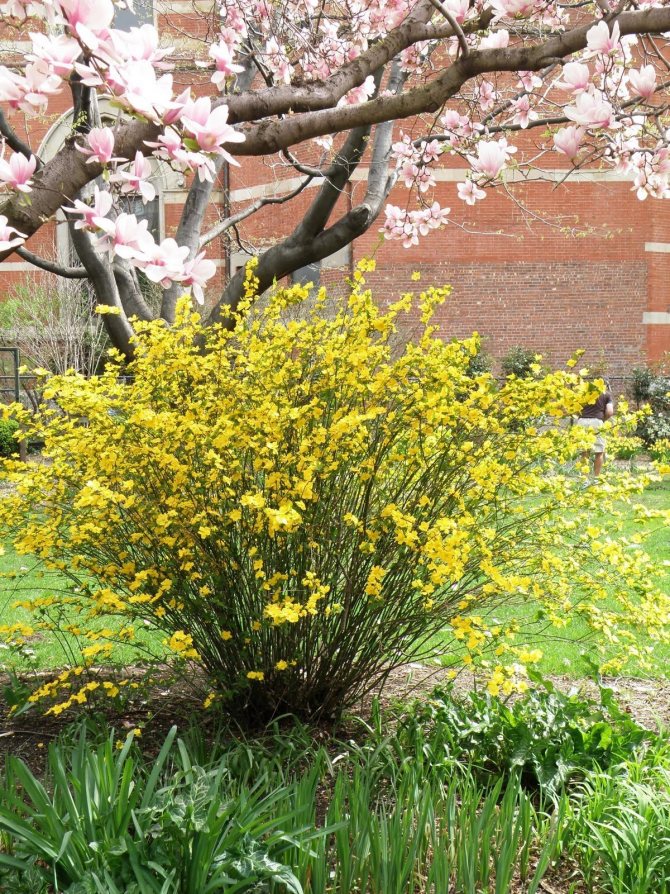

Kerria japonica (Kerria japonica)
Planting kerrias in open ground
When to plant kerria in the ground
Planting keria in open ground is carried out in early spring before the start of sap flow, or in the fall 1-1.5 months before the start of frost. Seedlings with a closed root system can be planted at any time of the year, except for winter.
- Kosmeya: growing from seeds, planting and care
The best site for a plant is a place protected from cold winds and well-lit by the sun. Kerria can grow in partial shade, but then its flowering will not be so abundant. However, in the direct rays of the sun, keria flowers quickly fade, so the best place for a shrub is the lace penumbra, which is given by large trees.
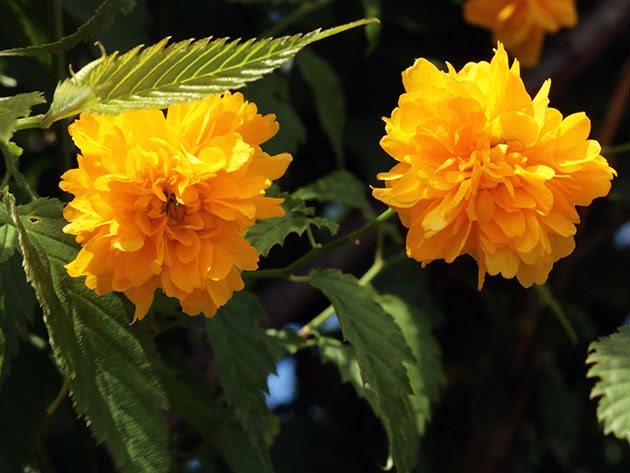

How to plant kerria
Like any forest plant, Japanese kerria loves moist fertile soil, rich in humus, and most of all - loamy. A pit for kerry is dug 60x60 in size and about 40 cm deep. A mixture of fertile garden soil, humus and sod land is poured into the bottom of the pit in a ratio of 2: 3: 3 with the addition of 60-80 g of complete mineral fertilizer.
A kerry bush is placed on the mound, its roots are straightened, and then the remaining space of the pit is filled with the same soil mixture, then the surface is lightly tamped and the seedling is watered abundantly. The root collar of the plant should be flush with the surface of the site.
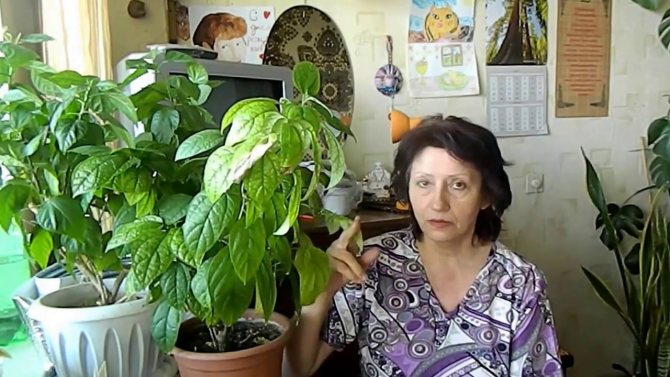

Features of planting kerrias
Japanese kerrias can be planted both in spring and autumn. For the middle lane, spring planting is considered preferable, but you can plant kerrias in the fall, provided there is good shelter for the winter - a month and a half before the arrival of stable frosts. In the spring, planting of seedlings is carried out before bud break. If you purchase seedlings of Japanese kerriya with a closed root system, then the plants can be planted during the entire active gardening season.
Kerria is planted in planting pits with a depth and diameter of about half a meter. In places with high soil moisture, the pits are made deeper and a high drainage layer is laid on the bottom. The removed soil is improved by adding organic and mineral fertilizers. Kerria is installed in the planting pit while maintaining the same level of deepening, with the root collar not lower than the soil level. After planting, it is necessary to carry out abundant watering and mulching.
Kerria japonica as a houseplant
When growing Japanese kerrias in a flower pot, they are kept in a cool place in winter. This plant hibernates in my basement (+ 7 ° C), at the end of February it moves to a glazed loggia (minimum night air temperature is + 12 ° C), and in March to the window sill in the room. This option is good for everyone, except for one thing: you have to constantly remove crumbled petals from wilted flowers from the windowsill and the floor. In the summer, a pot with a bush can be put on the site. Place it in a flowerpot, flowerpot, or dig it into the ground.
Care for kerrias in the garden
How to grow kerria
Caring for keria serves primarily to maintain a high level of decorativeness, and, as you know, only a healthy and well-groomed plant can be beautiful. Kerria in the open field needs regular watering, loosening the soil around the bush, weeding, feeding and pruning.
Water the kerrias as needed when the topsoil dries out.The plant especially needs moisture during the flowering period and in drought. Water for irrigation should be warm and settled. If the summer is rainy, watering may not be necessary, since the kerria does not like waterlogging. After watering or rain, loosen the soil around the bush and remove the weeds.
The cultivation of kerrias involves the introduction of fertilizers into the soil. After flowering, the plant is fed with mullein infusion (1:10) or matured compost with the addition of wood ash (dose - 100-200 g of ash per m²).
- Kosmeya: growing from seeds, planting and care


Kerria transplant
If necessary, the kerria bush tolerates transplanting well, and if the procedure is carried out with all care, then this can be done at any time of the year, except for winter and late autumn. But it is still better to replant kerrias in the spring or in October, when there are no leaves on the plant. Kerria is carefully dug around the perimeter of the crown projection, removed from the ground, transferred to a previously prepared hole and lowered into it along with an earthen lump. Then proceed as for the initial landing.
Within two weeks after transplantation, the kerria flower needs regular and abundant watering: the root zone must be saturated with moisture.
Reproduction of kerria
Reproduction of Japanese kerrias is carried out by vegetative methods: dividing the bush, layering, shoots and cuttings.
Lignified cuttings cut in April, green cuttings - in the middle of summer. The cuttings should have two buds, the lower cut is made oblique. Cuttings are planted in a cold greenhouse, which is placed in a light partial shade. The roots of kerria cuttings form well, but this process is not fast: the cuttings remain overwintered in the greenhouse, and only in May of next year they are planted in separate containers and grown at home. Kerria cuttings are planted in open ground in a permanent place after another year.
For breeding kerrias root suckers it is necessary to separate the shoots from the mother bush in early autumn and plant them. The filamentous root system in offspring is well developed, therefore, with regular watering and good care, a young plant in a new place adapts quite quickly.


It is also not difficult propagate kerria by layering: in the spring, before the sap flow begins, lay the kerria shoots in pre-dug grooves about 7 cm deep and fix them in this position. After one and a half or two weeks, new shoots will begin to grow from the buds of the layers, and when they reach a height of 10-15 cm, you need to sprinkle the grooves and shoots up to half the height with fertile soil. By the fall, the new plants will have roots and the cuttings can be removed and transplanted to a permanent location.
Dividing the bush often combined with a kerria transplant: after you dig out the bush, carefully release its roots from the ground and divide it into parts so that each of the divisions has developed roots and strong, strong shoots. Delenki are seated in pre-prepared pits in the same order as in the initial planting of kerria seedlings, and watered abundantly.
- Kosmeya: growing from seeds, planting and care
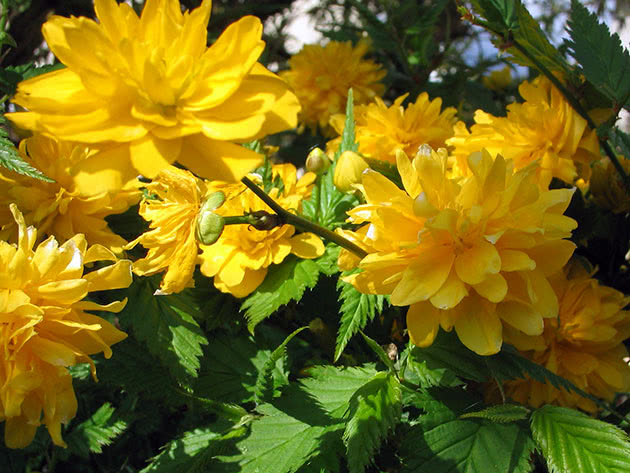

Kerria trimming
In early spring, before the buds swell, it is necessary to carry out a sanitary pruning of kerrias, that is, to cut out broken and dried shoots that have frozen over the winter to healthy wood, and shorten young and healthy ones by a quarter. As a result of pruning, the bush becomes dense and compact, and the flowering of kerria becomes abundant.
After flowering, you need to cut out four to five-year-old shoots of kerria to the base, and slightly shorten the young ones to maintain the lush shape of the bush.
Reproduction methods
Landing in the ground is carried out in spring or autumn, so that the kerria has time to take root before the onset of cold weather. The plant reproduces easily in several ways:
- cuttings;
- layering;
- undergrowth;
- dividing the bush.
Propagation by cuttings is a long process. Cuttings for propagation can be taken lignified - in April or green - in July. In both cases, when landing in a greenhouse, they should have 2 pairs of buds.In the spring of next year, when the roots are formed, they are planted in separate containers and transferred to a warm place until next spring, when planting in a permanent place becomes possible.
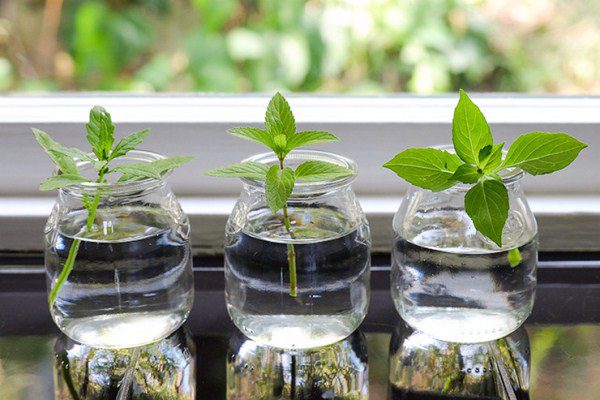

Cuttings of Japanese Kerria
Kerria propagates easier by layering. In early spring, shoots are laid in prepared shallow trenches. After 1, 5 months, after the emergence of young shoots from the buds, the trenches are sprinkled with soil. In autumn, shoots with a good root system are planted in the ground.
Kerria have a lot of root growth. In autumn, it is carefully separated with a sharp knife or shovel from the mother bush and planted in a separate place.
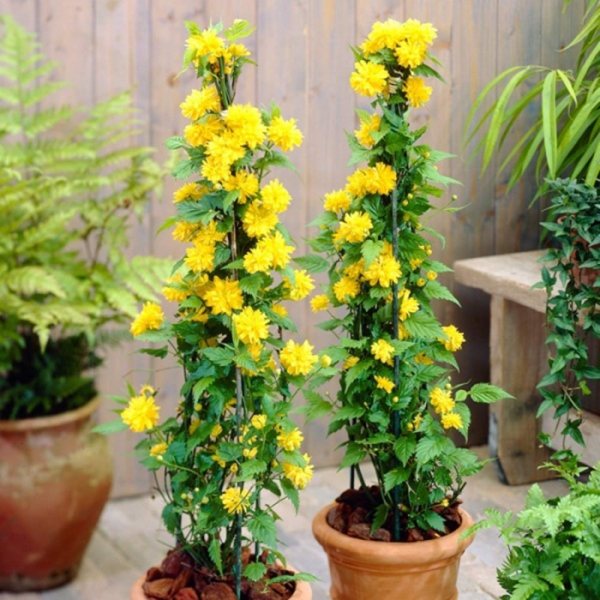

Kerria japonica is divided into bushes and planted in pots
To propagate kerria by dividing the bush, the plant is dug up, washed with water and divided into several parts so that each of them has healthy roots. Parts of the plant are planted in different places.
Kerria Japanese in landscape design
One of the new popular trends in landscape design is the bouquet planting of plants. With this method, shrubs and flowers are planted in one common or in different nearby dug holes. This composition looks very attractive. The main thing is to choose the seedlings correctly for joint planting. Plants intended for bouquet planting should have similar requirements for moisture, nutrition, light and develop at the same rate. Kerria Japanese will successfully fit into a bouquet with:
- the lilac in Memory of Ludwig Shpet and the lilac of Michelle Büchner;
- rhododendrons, hazel, magonia;
- derain, spirea, forsythia;
- phlox, tulips and daffodils.
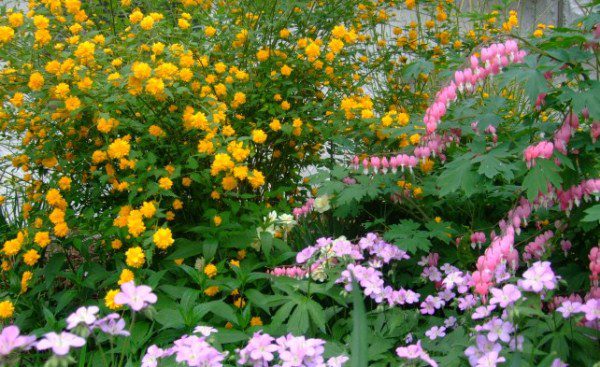

Kerria fits perfectly into the company of a large mixed flower garden Kerria is successfully placed as a bright accent in hedges, in mixed robots, in landscape plantings. Japanese kerria is a rather unpretentious shrub, able to stand out in the garden with its lush flowering several times per season. Gardeners successfully use this feature of the shrub to extend the life of the natural beauty of the garden in the short Russian summer.
The use of kerrias in ornamental gardening
Kerria japonica is equally good both as a single shrub (soloist) and in a large group. This plant is able to cope with any task. Kerrias can be combined with other shrubs and woody, herbaceous plants of any size, as long as they suit the same conditions.
Kerria can be used even in gardens of minimal size, in particular, on small patios of townhouses. It is a compact and highly decorative shrub that will not get lost in a large garden and can perform a variety of decorative tasks in medium-sized areas.
The main feature appreciated by kerrias is early and double flowering. This is one of the most spectacular spring flowering shrubs. As a spring or autumn accent, kerria is introduced into the baton of continuous flowering, grown in seasonal compositions.
Japanese kerrias are used in garden decoration:
- in hedges;
- on flower beds;
- in mixed discounts;
- in single flower beds;
- for decorating lawns (singly or in small groups);
- to create background arrays;
- to decorate the front garden;
- on meadows of ground cover;
- in landscape plantings.
This shrub thrives not only in open soil, but also in container culture. Whether in tubs, pots, or stone flower beds or plinths, the kerria will place magnificent accents in the garden, blend into a potted garden or add expressiveness to seating areas.
Japanese kerria can also be used for forcing, decorating winter and spring interiors with flowering twigs.
The best partners for the Japanese kerria are:
- hazel, rhododendrons, spiraea, forsythia, magonia, bladder, derain, cinquefoil and other landscape shrubs;
- decorative deciduous perennials and ground covers - heuchera, phlox, periwinkle, tiarella, tenacious;
- spring stars from tulips and daffodils to primroses and forget-me-nots
Kerria in the suburbs
Planting and caring for Japanese kerrias in the middle lane is carried out in the same manner and using the same techniques as in areas with a warmer climate, however, Japanese kerrias in the Moscow region or in the Leningrad region need mandatory shelter for the winter.
Kerria is covered in the second half of autumn, on a dry day: the shoots of the plant are bent to the ground, laid on a sheet of foam, fixed in this position, and covered with spruce branches on top or covered with dry foliage. A fixing frame is built over the plant, which will not allow the branches to straighten. The shelter for kerrias should be ventilated so that branches and shoots underneath do not spoil.
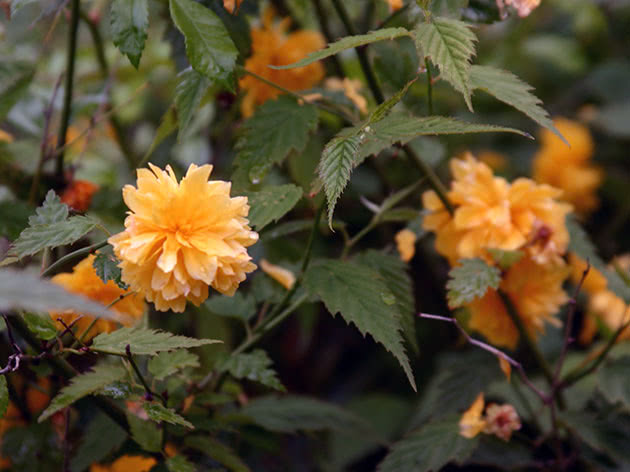

With the arrival of spring, on a dry but cloudy day, the plant is gradually freed from shelter. First, the frame is removed, and then the leaves. In sunny weather, it is advisable to cover kerrias from direct rays with a covering material, since the shoots can get burns, from which the plant will die. You can, of course, cut off the burnt shoots, but even after the growth of new ones, the kerry will not give abundant flowering, or it may not bloom at all.
Kerria japonica is the perfect shrub for lazy gardeners
I have a desire to grow unpretentious plants in the garden, but at the same time decorative for a long time. As far as possible, I collect just such plants. In addition to beautiful flowers, I draw attention to the beauty of the leaves and the overall silhouette. On this path, there are both pleasant discoveries and disappointments (where without them). Discovery was for me kerria shrub , capable of growing practically without my intervention, but at the same time growing tall and spreading, blooming profusely and for a long time (from April to October), having bright and rich green foliage.
Blooming ornamental shrubs in spring (read more)


Kerria japonica: An ideal shrub for lazy gardeners.
Garden forms of Japanese Kerria
There is only one type of Kerria - Japanese, however, on its basis, various garden forms have been derived. The most common ones are:
* Kerria Pleniflora. Forms a dense, erect shrub. Flowers - double, bright yellow, about 3 cm in diameter. It blooms in spring.
* Kerria Golden Guinea (Kerria Golden Guinea). The flowers are simple, but rather large - about 6 cm in diameter. The bush is attractive for its decorative foliage.
* Kerria Variegata or Picta (Kerria Variegata (Picta). The shrub is not tall, about 60 cm in height and twice as large in width. It has decorative gray-green leaves with a cream-white border. The flowers are simple, five-petalled.
- Kerria Albomarginata (Kerria Albomarginata). The leaves are quite graceful, bordered with a white stripe. The flowers are simple.
A little about the breeding of Japanese kerrias
The easiest way to breed kerrias is dividing a bush... Flexible shoots must be tilted as low as possible to the ground so that horizontal (air) layers are obtained.
To do this, you need to prepare a groove up to 7 cm deep and fix the shoot. A month later, when the leaves have already begun to appear, it is necessary to fill the groove with fertile soil. Only the end of the shoot should be left on the surface. Roots will appear in the fall. And you need to separate new cuttings in the spring.
An option is also possible with the separation of the shoot and its cultivation in a special place. The shrub tolerates transplanting well with the ground. And it is best to do this in the fall before the first cold weather. Cuttings, respectively, are recommended in the summer.
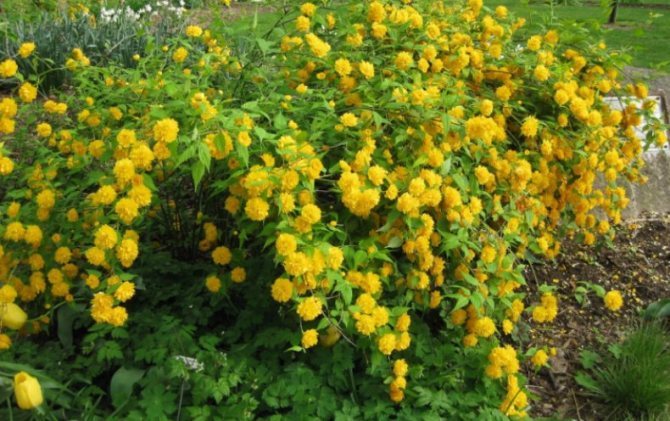

Japanese kerria or kerria japanese pleniflora
We will talk about such a beautiful and fabulous plant as kerria, this plant got its name in honor of William Kerr, he was the first gardener in the royal botanical garden on the island of Ceylon.And as you probably already guessed, it grows precisely in Japan, respectively, it is also called kerria japanese.
The plant itself is a shrub, a kerria shrub. This is an amazingly beautiful creation of Mother Nature. Its beauty lies primarily in the graceful and graceful structure of thin branches that form intricate, interesting patterns, it would seem, like any other Japanese plant. And of course, the leaves themselves complement this whole picture, which smoothly continue the image already set by the branches. They seem to have been carefully drawn by the skillful hand of a master, but we all know who the master really is.
The color of the plant is remarkably yellow, even more than yellow, the leaves are bright and even golden, pleasantly pleasing to the eye, the color is soft and does not hurt the eyes, the appearance of the plant is really very pleasant. However, noteworthy, there is another variety of this shrub - pink kerria, this kind also has a place to be and it, of course, is no less attractive and nice to the eye.
Flowering period
And now let's talk about the peculiarities of kerry as an object of nature. For example, about the period when it blooms. It blooms, oddly enough, in spring, this warm and, of course, favorable time for the flowering of any shrub. To be precise, this happens in the last days of May, then the Japanese kerria is just beginning to bloom. In addition, kerria, surprisingly, blooms several times: it blooms again at the end of summer, but, unfortunately, it does not bloom as abundantly as in spring in May.
Another simply amazing property or the peculiarity of this pleniflora is resistancelike a real Japanese samurai. Kerria itself is a Japanese plant very delicate, but, despite this, it withstands frosts well, and behaves hardy in winter, however, sometimes the ends of the shoots freeze in winter.
Probably, you are interested to know how such an unusual plant should be grown, now we will find out, because whatever the shrub is, you can find an approach to it and grow it safely. Kerria does not tolerate wind, especially cold, therefore, the landing must be carried out in a place sheltered from the winds.
Of course, one of the most important factors is the soil. For Japanese kerrias, moist fertile soil mixed with sand and containing clay is suitable.
It's not a secret for anyone that over time, any plant, a shrub or flower begins to dry out, of course, the plant will live a very, very long time if you take care of it correctly, but it constantly, however, with a certain frequency, changes in every possible way, and sometimes cuttings or individual the twigs on the kerrias begin to dry out. They need to be cut off so that the shrub can develop safely further, but this must be done at a certain time, it is advisable to cut off dead cuttings in April.
In these conditions, you can easily and, most importantly, correctly grow kerry, to summarize:
A brief description of the Japanese kerria
The name "kerria" comes from the name of the English plant lover William Kerr, who is said to have been the director of a botanical garden in Ceylon and, like all of us, was an enthusiastic collector of plants. Itself kerria japanese - the only representative in the genus Kerria, the Rosaceae family. It grows naturally in Japan and China.
It is a fairly tall, deciduous shrub that can grow up to two meters. Strong, powerful, bright green shoots grow upward and at an angle from the center of the bush. The ends of the branches are gradually bent downward and the whole bush takes on a very beautiful fountain shape.


Specific form of Japanese kerriya.
The leaves of Japanese kerria are elongated and toothed (up to 10 cm). They are saturated green on top and lighter on the bottom, as if corrugated, voluminous. Kerria blooms in April, and it is no coincidence that its popular name is "Easter rose".On the one hand, the beginning of flowering usually coincides with the Easter holiday, and on the other, the flowers are somewhat reminiscent of a small-flowered rose.
Under natural conditions, kerria flowers are simple, bright yellow, but most likely you will get Japanese kerria. Pleniflora, which has double flowers of the same yellow color, which gradually turns white from the edges to the center.
Flowers are single and scattered throughout the shoot, there are many of them, they are up to 5 cm in diameter. During flowering, it is impossible to pass by this bush without paying attention to it. Tall, sprawling, bright green, with rich yellow flowers - he is very good.
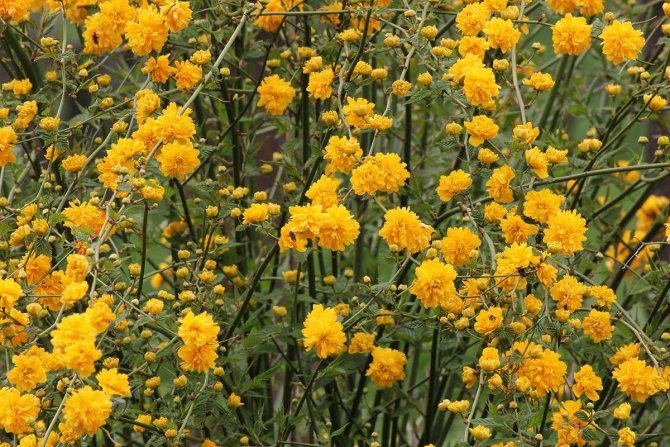

Kerria Japanese 'Pleniflora'.
By the way, unlike most flowering shrubs, Japanese kerria does not look sloppy after flowering, the flower has withered and has disappeared, unfortunately or to joy, in our area it does without the formation of fruits.
And even in winter, after the foliage has fallen, kerria looks great. It's just a fountain of green twigs! Perhaps only kerria and dogwood with their red branches can add color to a snowy winter garden.
Another interesting form of Japanese kerriya is variegated, or more correctly - Variegata... This is a much smaller bush (maximum 60-70 cm) with small light green leaves with white edging (up to 3 cm) and inconspicuous simple small yellow flowers (up to 2.5 cm).
To be honest, I value this form of kerria not for flowering, but for its ability to maintain the shape of a light green (almost gray) ball, almost without my intervention. Sometimes this is needed in garden compositions.
Care
The shrub, although quite hygrophilous, nevertheless does not tolerate excessive moisture. It must be watered regularly during the flowering period and in extreme heat, while avoiding stagnation of moisture in the soil. Once a week, it is necessary to include mineral fertilizing in the water for irrigation in the form of special preparations for ornamental and flowering crops.


Important! Top dressing is carried out only on kerrias older than two years, since the roots of a young shrub are too tender and can get burned from fertilizers
Regular pruning is an important part of grooming. It is held in the spring, after the end of frost. Frozen, broken and dry branches are cut off, and good shoots are shortened by a third for more stimulation for branching. After the flowering period, pruning is also carried out - the shoots that did not bloom are removed, and those that did not have flowers are left, it is on them that they will appear in the fall. In the same period, it is worth pruning all branches older than 4-5 years. Overgrown kerria is periodically thinned out.
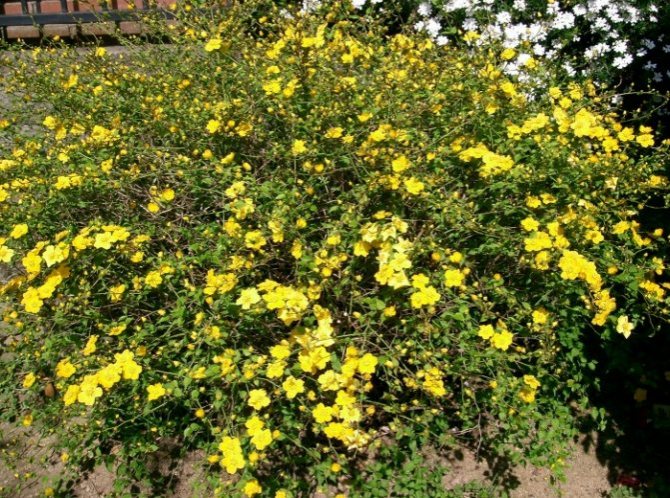

Since the shrub can suffer from frost, it is recommended to cover it for the winter, with the onset of cold weather (from mid-October). The procedure for preparing for winter is carried out in dry weather: the bushes, bent to the ground, are laid on a dry substrate made of foam or other material and fixed with a frame made of stakes. This ensures reliable protection of the branches from damage. Then dry leaves or shavings are poured, and two layers of lutrasil are laid on top. The resulting protective structure should be well ventilated and dry, not allowing the plant to rot. In spring, the shelter opens in stages after the frost stops, preferably in cloudy weather, so that young roots do not get sunburn.
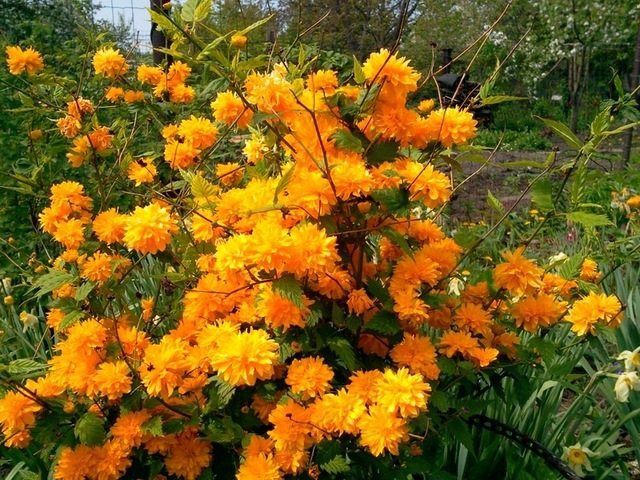

Attention! Kerria, which suffered from frost in the winter, quickly recovers in the spring, but blooms less abundantly this year.
The plant propagates by cuttings, root suckers or branches, which quickly take root. It is recommended to replant offspring in early autumn, and cuttings and layering - in April.
Plant care
- Kerria Japanese does not tolerate stagnant water. Care must be taken to ensure that the plant does not dry out. During flowering and in dry weather, watering is carried out more often.
The water should be settled, warmed up in the sun. Do not use a hose. - After watering, it is recommended to well loosen the soil around the trunk and mulch it with chopped bark or cut grass.
- Regular weeding required: Kerrias don't like being near weeds.
- Kerria responds well to feeding. In the spring of her fertilized with a complex mineral fertilizer... After the last flowering in autumn, a shrub fed with mullein infusion or compost using ash.
- The shrub grows quickly, due to which needs a regular haircut, during which dry flowers and branches are removed. Healthy branches are pruned by 1/3.
Corrective pruning will provide the plant with a compact, well-groomed appearance and long-lasting beautiful flowering. - After the autumn bloom the plant needs to be prepared for winter... For this, the bush is watered. The soil around the trunk is covered with spruce branches, and the shrub is well covered with non-woven materialby throwing it over the frame installed around it. In the spring, when the threat of frost and sunburn passes, reliable protection is removed. If any shoots are still damaged, they are cut off.
Conditions Needed by Carries
Kerria perfectly adapts to a wide variety of lighting conditions. This shrub will be an adornment of both sunny and light, and semi-shady, and even shady locations, where only white-flowering shrubs can compete with kerry in the effect of highlighting. The possibility of growing large trees even in the diffused shade without completely losing the ability to bloom luxuriantly can be explained simply: kerria begins a parade long before the bulk of the leaves bloom from the trees. But the intensity and abundance of flowering kerrias in strong shade is reduced compared to plants growing in open areas. In sunny southern places, the flowers are prone to fading. When choosing a place for planting kerrias, it is worth remembering that the plant does not like open and blown places, is not wind-resistant enough due to the fragility of the shoots, and will fully reveal its beauty only in protected areas.
The soil requirements for this shrub are also quite modest. Kerria is able to take root anywhere, but it achieves the greatest decorative effect on high-quality garden soils. Kerria japonica prefers moderately moist soils, it can grow even in dampness, provided that good drainage is laid. The main thing is that the soil is loose, loamy or sandy loam, not too fertile and not depleted. During planting, it is worth adding sand to heavy soil, organic and mineral fertilizers to infertile soil.
One of the main advantages of kerry is its resistance to contaminated environment. It can be used in urban landscaping, decorating areas near highways and other places with increased gas pollution.


Japanese kerria (Kerria japonica).



